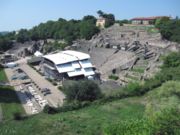
Antique theatre of Fourvière
Encyclopedia

Roman theatre (structure)
The characteristics of Roman to those of the earlier Greek theatres due in large part to its influence on the Roman triumvir Gnaeus Pompeius Magnus. Much of the architectural influence on the Romans came from the Greeks, and theatre structural design was no different from other buildings...
is a Roman
Roman architecture
Ancient Roman architecture adopted certain aspects of Ancient Greek architecture, creating a new architectural style. The Romans were indebted to their Etruscan neighbors and forefathers who supplied them with a wealth of knowledge essential for future architectural solutions, such as hydraulics...
ancient structure in Lyon
Lyon
Lyon , is a city in east-central France in the Rhône-Alpes region, situated between Paris and Marseille. Lyon is located at from Paris, from Marseille, from Geneva, from Turin, and from Barcelona. The residents of the city are called Lyonnais....
, France. It was built next to the hill of Fourvière
Fourvière
Fourvière is a district of Lyon, France located on a hill immediately west of the old part of the town, rising abruptly from the river Saône and then gently sloping down to the north-west. It is the site of the original Roman settlement of Lugdunum...
, which is located in the center of the Roman city.
Chronology
The theatre was built in two steps: around 15 BC, a theatre with a 90 m diameter was built next to the hill. At the beginning of the 2nd century, the final construction added a last place for the audience. The diameter is 108 m, and there were seats for 10,000 people.Nowadays, the theatre is primarily a tourist site, but it is still used as a cultural venue. Each year, the Nuits de Fourvière festival takes place in the theatre.
See also
- Odeon of LyonOdeon of LyonThe Odeon of Lyon is a small ancient Roman theatre near the summit of the Fourvière hill in Lyon, France. It forms a pair with the theatre, one of only two such pairs in Gaul .-History:...

